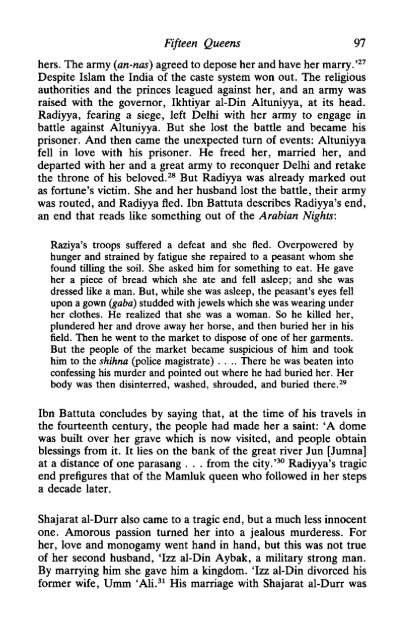Fatima.Mernessi_The-Forgotten-Queens-of-Islam-EN
Fatima.Mernessi_The-Forgotten-Queens-of-Islam-EN
Fatima.Mernessi_The-Forgotten-Queens-of-Islam-EN
You also want an ePaper? Increase the reach of your titles
YUMPU automatically turns print PDFs into web optimized ePapers that Google loves.
Fifteen <strong>Queens</strong> 97<br />
hers. <strong>The</strong> army (an-nas) agreed to depose her and have her marry.' 27<br />
Despite <strong>Islam</strong> the India <strong>of</strong> the caste system won out. <strong>The</strong> religious<br />
authorities and the princes leagued against her, and an army was<br />
raised with the governor, Ikhtiyar al-Din Altuniyya, at its head.<br />
Radiyya, fearing a siege, left Delhi with her army to engage in<br />
battle against Altuniyya. But she lost the battle and became his<br />
prisoner. And then came the unexpected turn <strong>of</strong> events: Altuniyya<br />
fell in love with his prisoner. He freed her, married her, and<br />
departed with her and a great army to reconquer Delhi and retake<br />
the throne <strong>of</strong> his beloved. 28 But Radiyya was already marked out<br />
as fortune's victim. She and her husband lost the battle, their army<br />
was routed, and Radiyya fled. Ibn Battuta describes Radiyya's end,<br />
an end that reads like something out <strong>of</strong> the Arabian Nights:<br />
Raziya's troops suffered a defeat and she fled. Overpowered by<br />
hunger and strained by fatigue she repaired to a peasant whom she<br />
found tilling the soil. She asked him for something to eat. He gave<br />
her a piece <strong>of</strong> bread which she ate and fell asleep; and she was<br />
dressed like a man. But, while she was asleep, the peasant's eyes fell<br />
upon a gown (gabd) studded with jewels which she was wearing under<br />
her clothes. He realized that she was a woman. So he killed her,<br />
plundered her and drove away her horse, and then buried her in his<br />
field. <strong>The</strong>n he went to the market to dispose <strong>of</strong> one <strong>of</strong> her garments.<br />
But the people <strong>of</strong> the market became suspicious <strong>of</strong> him and took<br />
him to the shihna (police magistrate) .... <strong>The</strong>re he was beaten into<br />
confessing his murder and pointed out where he had buried her. Her<br />
body was then disinterred, washed, shrouded, and buried there. 29<br />
Ibn Battuta concludes by saying that, at the time <strong>of</strong> his travels in<br />
the fourteenth century, the people had made her a saint: 'A dome<br />
was built over her grave which is now visited, and people obtain<br />
blessings from it. It lies on the bank <strong>of</strong> the great river Jun [Jumna]<br />
at a distance <strong>of</strong> one parasang . . . from the city.' 30 Radiyya's tragic<br />
end prefigures that <strong>of</strong> the Mamluk queen who followed in her steps<br />
a decade later.<br />
Shajarat al-Durr also came to a tragic end, but a much less innocent<br />
one. Amorous passion turned her into a jealous murderess. For<br />
her, love and monogamy went hand in hand, but this was not true<br />
<strong>of</strong> her second husband, 'Izz al-Din Aybak, a military strong man.<br />
By marrying him she gave him a kingdom. 'Izz al-Din divorced his<br />
former wife, Umm 'Ali. 31 His marriage with Shajarat al-Durr was


